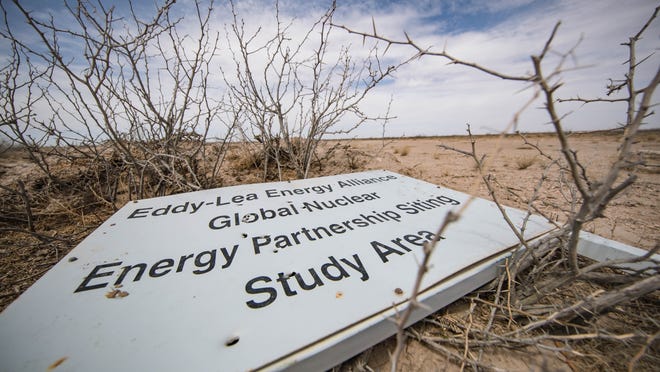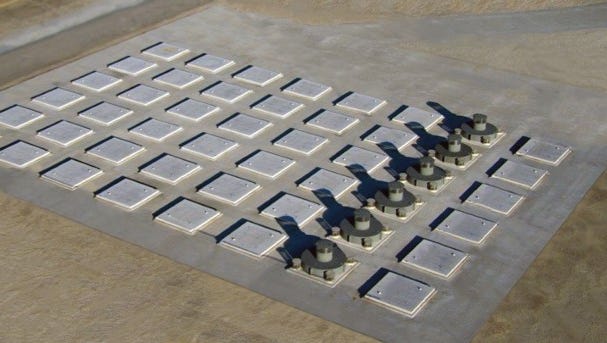
A proposed storage facility for spent nuclear fuel in West Texas near the New Mexico border will have no impact on the environment, per a federal report released Thursday.
The Nuclear Regulatory Commission (NRC) issued its final environmental impact statement (EIS) for a proposal by Interim Storage Partners, a joint venture between Waste Control Specialists (WCS) and Orano USA, to build a storage facility for the waste at WCS’ facility in Andrews, Texas.
The proposal would ultimately bring about 40,000 metric tons of spent nuclear fuel rods from reactors across the county to be stored on a temporary basis while a permanent repository is developed.
More:Waste Isolation Pilot Plant needs more space to dispose of nuclear waste, officials say
The initial license application was for 5,000 metric tons, but the company voiced its plans to expand the facility to hold more waste.
A permanent repository does not exist in the U.S. as a project to build one at Yucca Mountain, Nevada was halted by the administration of former-President Barrack Obama in response to opposition from state leaders.
Without a permanent resting place for the waste, opponents worried the facility designed to be temporary could become permanent and bring the risk of radiation exposure to the local communities in the region during the facility’s operation and the transportation of the waste into the site.
More:New Mexico lawmakers warned of dangers of nuclear waste facility proposed near Carlsbad
These concerns were like those voiced for another temporary storage site over the border in New Mexico, where Holtec International proposed building its facility to hold more than 100,000 metric tons of the waste at a remote location between Carlsbad and Hobbs.
Both sites were within the oil-rich Permian Basin and government leaders cautioned they could risk other major industries like fossil fuel extraction and agriculture.
But in its environmental analysis for both the ISP and Holtec projects, the NRC found no risk to the environment.

More:Nuke waste from Cold War coming to Waste Isolation Pilot Plant from Idaho National Laboratory
Holtec’s EIS was released in March 2020, and the NRC’s report on the ISP project continued the agency’s support of the facilities and method of removing high-level nuclear waste from generator sites, often near large bodies of water and high population areas, and placing the fuel in the remote desert of southeast New Mexico and West Texas.
“After considering the environmental impacts of the proposed action, the NRC staff recommend granting the proposed license,” read an NRC statement announcing the release of the latest EIS.
A draft EIS was issued by the NRC in May 2020 for the Texas site, followed by four public meetings and public comments.
More:New Mexico leaders oppose Holtec International nuclear waste site proposed near Carlsbad
The NRC reviewed about 2,500 unique comments submitted by more than 10,000 people, records show.
The final EIS will be issued to the U.S. Environmental Protection agency and be published in the federal register.
Once the EIS is published, the NRC can issue a license for the facility in 30 days.
Issuance of the license will be followed by the NRC releasing its final safety evaluation and technical review of the project.
More:WIPP: Lawmakers briefed on plans to up nuclear waste shipments to facility near Carlsbad
Holtec’s project in New Mexico appeared to be stalled from the final EIS as the New Mexico Attorney General’s Office filed a lawsuit to block the proposal earlier this year amid stern opposition from New Mexico Gov. Michelle Lujan Grisham.
New Mexico Environment Department Cabinet Secretary James Kenney said his state’s administration was also against the Texas site, as it could risk New Mexicans due to its location near the states’ border.
“I think the administration has been clear that New Mexico is not the right state for spent nuclear fuel,” Kenney said. “Nor do we believe placing it five miles over the border in Texas is right for New Mexico. There’s no difference in the risk.”
More:WIPP: $100 million contract awarded for tech support at nuclear waste site near Carlsbad
In a statement following the release of the final EIS, Interim Storage Partners said the approval was further proof that the project would be safe to operate.
“We appreciate the rigorous and deliberate process of the Nuclear Regulatory Commission to thoroughly investigate the environmental soundness of our license application,” the statement read.
“Today’s announcement by the NRC issuing its Final Environmental Impact Statement for Interim Storage Partners’ license application is another indication of our application’s quality and thoroughness.”
More:8th panel for nuclear waste disposal at Waste Isolation Pilot Plant will be ready in 6 months
The Texas project also faced heavy opposition from government, including Republican Texas Gov. Greg Abbott and 63 Democrat state lawmakers who contended in a June 23 letter that both the Holtec and Interim Storage Partners projects should be denied licenses as they allegedly violated federal law.
The lawmakers argued the Nuclear Waste Policy Act outlawed temporary storage of the waste before a permanent repository was available.
They also worried an incident at the proposed sites could imperil local groundwater sources, and that the area was subject to extreme weather and sinkholes that could threaten the safety of the project.
More:New contract sought to move nuclear waste to Waste Isolation Pilot Plant near Carlsbad
Because of its proximity to the Texas border, lawmakers argued the Holtec site would also put Texas at risk should it be allowed to open.
“Both projects are illegal under the Nuclear Waste Policy Act since no U.S. repository exists. Both would result in transport of radioactive waste through Texas. Both licenses should be denied,” the letter read.
“Bringing this nuclear reactor waste to Texas and New Mexico would result in dangerous de-facto permanent dumps.”
More:Nuclear solution for New Mexico’s economy could be key to storing Northeast’s spent fuel
Local governments in five Texas counties and three cities passed resolutions opposing the facility, representing 5.4 million Texans.
Andrews County, the site of the proposed site, voted unanimously earlier this month to oppose the project in Texas, per local news reports, reversing course after a resolution in support was passed in 2015.
In its resolution approved in April 2017 when the company first filed for its license, Dallas County opposed the facility as the waste would likely be transported to the ISP facility via rail through the Dallas-Fort Worth metro area.
“Our lives, land and aquifers must be protected from radioactive contamination which could result from accidents, radiation releases or leaks or terrorist actions during thousands of spent nuclear fuel waste shipments that could occur for a period of 24 years if consolidated storage is licensed,” the resolution read.
Adrian Hedden can be reached at 575-618-7631, achedden@currentargus.com or @AdrianHedden on Twitter.






